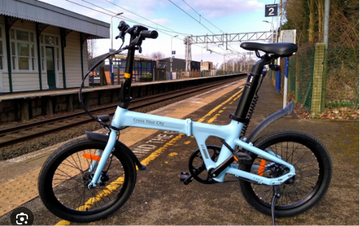What are the components and detailed structure of an electric power-assisted bicycle? (P1)
by Vy Nhat on Jun 01, 2023

Hello everyone, currently there are many different brands and models on the electric bicycle market. So do you know what components and structures to create a power-assisted electric bike?
1. Components and structure of electric power-assisted bicycles

See also: Bicycle ADO A26S VEHICLE
- Suspension fork
Suspension fork is a component on a bicycle that is equipped to reduce shock and vibration for the rider when traveling on rough terrain. It is mounted directly on the front part of the chassis and usually consists of two forks (also known as forks) and a spring (also known as a spring or shock absorber). When the bike rides on uneven terrain, the suspension fork absorbs and dampens the rider's shock, helping to minimize the feeling of shaking and ensure the rider's vision is not shaken. The suspension fork can adjust the soft stiffness of the shock absorber to suit the terrain conditions and the rider's weight. A suspension fork is one of the key features on mountain bikes and mountain bikes, making it easier and safer for riders to navigate rough terrain.
- Handlebars
Handlebars are parts on bicycles used to control the direction of the bike. It consists of a crossbar that is attached to the front part of the bike and placed a certain distance away from the frame so that the rider can grasp and control the direction of the bike.
There are different types of handlebars used on different types of bikes, including:
Flat handlebars: straight horizontal bars and commonly used on mountain bikes and urban bikes. It gives the driver good control over the direction of the vehicle and also allows changing the driving position to reduce strain on the neck and shoulders.
Drop handlebars: curved crossbars and are often used on racing bikes. It allows the driver to change the driving position and reduce the wind resistance to increase speed.
Riser handlebars: horizontal bars that curve upwards and are often used on mountain bikes. It helps the driver to control the vehicle easily on rough terrain.
Handlebars are one of the important parts on a bicycle, helping the rider to control and control the bike safely and easily.
- Stem
The stem (also known as the handlebars) is the part on the bike between the handlebars and the fork steerer tube, which connects the handlebars and handlebars to the frame. Stem helps the driver adjust the height and length of the handlebars to suit the driving position and personal preferences.
Stems come in a variety of lengths, diameters and inclines to suit different bike types and riders' personal preferences. Stems are usually made of aluminum or aluminum alloys, for durability and relative lightness.
In addition to the function of adjusting the riding position, the stem also plays an important role in increasing the stability and control of the bike. If the stem is installed improperly or does not fit the handlebars and chassis, it can cause some handling problems, such as shaking or difficulty in handling. Therefore, choosing and installing the correct stem is very important to ensure safety and performance when using the bike.
- Frame
The bicycle frame is the main part of a bicycle, it consists of many components that are put together to form a strong structure and support the entire system of the bike. Bicycle frames are usually made of different materials such as steel, aluminum, carbon, titanium or alloy. The bicycle frame consists of many components, including: Head tube: the top part of the frame, containing the shock absorber and steering wheel Top tube: the upper horizontal part of the frame connecting the head tube and seat tube Down tube: the lower horizontal part of the bicycle frame. frame, running from head tube to bottom bracket Seat tube: longitudinal section connecting the head tube and rear triangle, where the saddle is attached to Chainstays: two horizontal tubes running parallel to the chain, connecting the bottom bracket and rear dropouts Seatstays: the two vertical tubes connecting the rear dropouts and the top tube or seat tube The bicycle frame supports the weight of the rider, the wheel system and other parts of the vehicle, and helps transmit thrust from the bike. the driver to the wheel to create momentum for the car to run. In addition, the frame also plays an important role in controlling the speed, stability and bearing of the bike when riding on different terrain. The right choice and design of the frame will help the rider have a better, safer and more efficient riding experience.
- Saddle clamp
Saddle clamp is the part on a bicycle that is used to clamp and secure the saddle in a fixed position on the saddle tube of the chassis. Saddle clamps are usually made of aluminum or aluminum alloy to ensure durability and lightness. It consists of two main parts, the clamping bolt and the clamping ring. The clamp is a small rod that is fastened to the saddle and can be adjusted to change the position of the saddle on the saddle. The clamp is a circle that is placed around the saddle tube and can be tightened with a clamp to hold the saddle in place. To change the position of the saddle on the saddle, the user can loosen the clamp by tightening the clamp screw and then moving the saddle to the desired position. Once the correct position is reached, the user simply tightens the clamp to keep the saddle in that position. Saddle clamp is an important part of the bike, ensuring that the saddle is held in place and safe for the rider.

See also: ADO Air 20 . power-assisted bicycle




